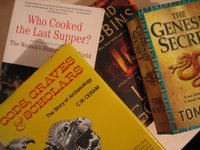I've Been Catching Up.
 Doing quite a bit of reading on this trip.
Doing quite a bit of reading on this trip."The Genisis Secret," by Tom Knox is a rather bloodthirsty novel whose fascination is that it is set around Gobekli Tepe an actual archeaological site of a temple some 12,000 years old which, for a still unknown reason, was covered over about 6,000 BC. The novel led me to read much more on-line .
The classic "Gods, Graves & Scholars," by C.W Ceram is a marvelous histroy of Archaeology since the early 1700s; detailing the achievements of a number of colourful (often) dilettantes who dedicated their lives to the discovery of sites, languages and culture of civilisaions long burried.
Less well written, David Gibbins' "The Last Gospel" also involves archaeolgists and a find in Herculaneum's Villa of the Papyruses: an appropriate read on the train hurtling towards Naples.
A rather angry Rosalin Miles re-christened her "Women's History of the World" to "Who Cooked the last Supper?" indicative of some of the wry humour interspercing the indignation within.
<< Home